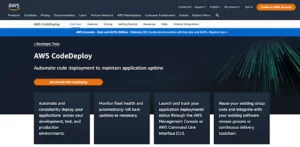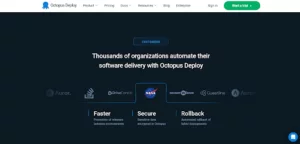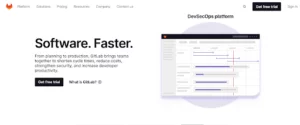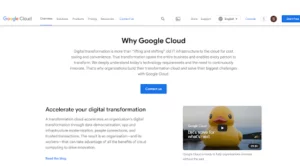It’s common to think of CI and CD as two names for the same process but there is a big difference. While continuous deployment refers to the deployment of code to the production environment, continuous delivery refers to the distribution of code to the testing teams.
Businesses using software development techniques can benefit greatly from the efficiency gains offered by continuous deployment. Businesses can respond swiftly to changing customer needs by testing new concepts and services.
Teams may respond to consumer feedback almost instantly when they have a Continuous Deployment process. Teams may react rapidly to consumer issue reports or requests for new features by deploying updates and adjustments. As a result, new features and updates are made available to customers as soon as the code is put into production.

Advantages of Choosing the Right Continuous Deployment Tools
Software deployment is essential. You must do much more than code the program to provide your clients with the best experience possible. You must also perform tests, examine various versions, report application bugs, and do much more. All of these may require financial and human resources. Because of this, using superior software deployment tools has several advantages for your company.
The following are some benefits of selecting the proper software deployment tool:
- Automation
Software deployment management involves a lot of manual labor, and SDTs speed up the processing by automating most processes. As a result, the organization may operate with less physical labor from people, saving time and money. Using the appropriate SDTs, various tasks such as bug fixes, patch protection, performance testing, and code analysis can be fully automated.
However, automation should be done carefully since it might otherwise make more noise. For instance, some tools may automatically generate alerts on unimportant subjects, and Additionally, the team’s time and effort are wasted.
- Increased Safety
Because they recognize how crucial your data is, almost all SDTs offer reliable cybersecurity services. You have control over access and permissions with the appropriate SDTs. Administrators may modify these rights in the settings and only permit users who require access.
- Consistent Updates
No program can ever be delivered flawlessly all at once. To better shape the evolution of their products, software owners first seek to comprehend the engagement created by their apps. However, poorly planned software upgrades might result in security flaws that leave your product open to attacks.
Updates and maintenance are flawlessly handled automatically by SDTs. They practice patch management across all apps, automate system upgrades, and search for vulnerabilities. They cut down on the time and money needed to manage software upgrades.
- Transparent Monitoring
One of the most essential duties for the success of software is monitoring. You must keep track of your application’s overall performance and the challenges your users are encountering. You can understand the effects of your deployment by using the correct SDTs, which have monitoring tools built directly into their process.
Checking your application’s progress on development and problem fixes is made easier with transparent monitoring. Every modification and action made to your program may be seen remotely.
- Fewer mistakes
Your application will be deployed more frequently if you automate your deployment process. You can also set up checks that will be run automatically during each deployment.
For instance, if you add unit test and code style checks to your CI/CD server, only builds that pass the unit test and code style checks will be released. It reduces the likelihood of pushing flawed and broken code into the repository.
- Quick Comments
It is incorrect in this digital age to believe that releasing an application with your choice features will make it popular. Companies now release features infrequently but separately to receive feedback on each feature. The program may be deployed many times per week or multiple times per day with the aid of the deployment tool.
Contributing Factors For Continuous Deployment

- Core Features:
The most crucial elements for any software deployment tool are the features.
Every business wants the functionality to fulfill the reason they purchased the product.
Any organization would typically look for key capabilities in any SDT, such as memory leak detection, alerting on failed builds, metrics visualization on a graph, and N+1 queries. In addition, having too many features is bad since it clogs up the UI and application with pointless noise.
- Security
When selecting a deployment tool, one of the most crucial things to consider is your application’s security. Many secret passwords or keys are used while deploying software.
These might provide attackers with unauthorized access if they are unintentionally exposed. To prevent the exposure of critical data, an SDT should be cautious enough to put security measures in place and notify teams.
- Worth the Money
Every company strives to save costs. Thus software deployment must be economical. Nevertheless, you must maintain the tool’s quality. Finding the ideal balance between cost and quality is crucial when selecting high-quality software for your deployment process.
- Customer support
Everyone, whether an individual or a business, occasionally requires help. The SDT supplier must offer dependable customer service. It would be better to avoid becoming trapped just before a crucial upgrade and having no one on the support staff there to assist you.
- Integration with Third Parties
Any tool must be able to communicate with other devices to be helpful. Your chosen software deployment solution must include a sufficient number of third-party connectors to connect to your preferred workspace/collaboration tool. Alerts and simple activities may become tiresome chores in the absence of these integrations.
- User interface
Software development tools’ user interface (UI) must be simple and make all its functions readily visible to users. A nice user interface also reduces the hardware required to navigate the SDT’s many functionalities. If so, awkward dashboards alone will convince people not to purchase your product.
- Learning Curve
The tools that are the simplest to understand are the ones that are most often used. Your staff must become as comfortable with the SDT’s functionality and interface as soon as feasible. Simplifying the UI of a tool with several capabilities might be challenging. The best tools are those that can blend functionality and usability.
Top Continuous Deployment Tools
#1) AWS CodeDeploy
Best continuous deployment tool for small to large businesses.
Price: AWS doesn’t charge any cost for code deployments through CodeDeploy on Amazon EC2 or AWS Lambda. For on-premises instances, you have to pay $0.02 per on-premises instance.

AWS CodeDeploy will help you with the application deployments to Amazon EC2 instances, on-premises instances, serverless Lambda functions, or Amazon ECS services. It provides features as Automated Instance Deployments, Minimized Downtime, Centralized Control, and Ease of Adoption.
Pros:
- Automation: CodeDeploy automates the deployment process, saving time and reducing the risk of human error during deployment.
- Scalability: CodeDeploy can scale to handle large-scale deployments across multiple instances and regions.
- Customization: CodeDeploy allows for a high degree of customization, including custom deployment scripts and configurations.
- Integration: CodeDeploy integrates with other AWS services such as AWS CodePipeline, AWS Elastic Beanstalk, and AWS CloudFormation.
- Cost-effective: CodeDeploy is cost-effective and charges based on the number of instances deployed rather than the number of deployments.
Cons:
- Learning curve: CodeDeploy has a learning curve, especially for users who need to become more familiar with AWS services.
- Limited support for other platforms: CodeDeploy primarily supports Amazon EC2 instances, which may limit its use for organizations that use other platforms.
- Lack of built-in rollback: CodeDeploy does not have a built-in rollback mechanism, which means that if a deployment fails, it may require manual intervention to roll back to the previous version.
- Limited visibility: CodeDeploy provides limited visibility into the deployment process, making diagnosing and resolving issues challenging.
AWS CodeDeploy can be a useful tool for automating deployment processes and scaling deployments. Still, it may require some learning and may not be the best fit for organizations that use non-AWS platforms or need more advanced deployment features.
#2) Octopus Deploy
Best continuous deployment tool for small to large businesses.
Price: Octopus Deploy has two solutions, i.e., Cloud Deployment as a service ($45 per month) and Server Octopus on Your Infrastructure ($2300 per year for 25 deployment targets).
Octopus on your infrastructure will be free for ten deployment targets. A free trial is available for 30 days for a cloud-based solution.

The teams of any size can organize releases and deploy applications with the aid of this deployment automation server. You can either deploy locally or on the cloud using it.
It can manage high-level deployment procedures for platforms like.NET, Java and others.
It can manage complex deployment patterns with ease. The agent that Octopus provides for deployment to virtual machines is called Tentacle.
Pros:
- Easy to use: Octopus Deploy is a user-friendly, intuitive, and easy-to-use interface, making it easy to navigate and configure.
- Robust deployment options: Octopus Deploy provides numerous deployment options, including deployment to cloud platforms such as Azure and AWS and on-premises and hybrid environments.
- Extensibility: Octopus Deploy supports a variety of integrations and plugins that allow for customization and extension of its functionality.
- Configuration management: Octopus Deploy provides configuration management, making deploying multiple applications across multiple environments easier.
- Scalability: Octopus Deploy can easily scale to support large-scale deployments, making it suitable for organizations of any size.
Cons:
- Limited customization of deployment scripts: Octopus Deploy provides a range of options for customization, but it cannot be easy to modify deployment scripts beyond the options provided.
- Cost: Octopus Deploy can be expensive, with pricing based on the number of deployments and target machines.
- Limited support for some platforms: Octopus Deploy may only support some platforms, which can limit its use for organizations that use other platforms.
- Learning curve: Octopus Deploy has a learning curve, especially for users who need to become more familiar with deployment and release management tools.
Octopus Deploy is a powerful and user-friendly deployment automation tool that provides robust deployment options and configuration management, making it suitable for organizations of any size. However, it may only support some platforms, can be expensive and has a learning curve.
#3) Jenkins
Best continuous deployment tool for small to large businesses.
Price: Free and open source.

A free and open-source technology called Jenkins will automate the product’s development, testing, and deployment. It supports UNIX-like operating systems, Windows, and Mac, and it will function as a straightforward CI server and a continuous delivery hub.
Pros:
- Open-source: Jenkins is open-source software, which means it is free to use, and the source code is available for anyone to view and modify.
- Flexibility: Jenkins provides a wide range of plugins and integrations, making it highly customizable and suitable for various use cases.
- Extensibility: Jenkins can be extended using plugins and custom scripts to add additional functionality, making it a powerful tool for automation.
- Scalability: Jenkins can scale to handle large, complex projects and multiple users.
- Community support: Jenkins has a large and active community of developers who contribute to the platform’s development and provide support and guidance to users.
Cons:
- Complexity: Jenkins can be complex to set up and configure, particularly for users who need to become more familiar with the platform or DevOps concepts.
- Maintenance: Jenkins requires regular maintenance and updates to ensure the platform is secure and functioning correctly.
- Security: Jenkins can be vulnerable to security risks if not configured properly, and it is the user’s responsibility to ensure the platform is secure.
- Limited visibility: Jenkins provides limited visibility into the deployment process, making diagnosing and resolving issues challenging.
- Learning curve: Jenkins has a steep learning curve, especially for users unfamiliar with the platform or DevOps concepts.
Overall, developers and DevOps teams widely use Jenkins as a powerful and flexible automation tool. However, it can be complex to set up and configure, requires regular maintenance and updates, and has a steep learning curve.
#4) TeamCity
Best continuous deployment tool for small to large businesses.
Price: Professional server license is free for 3 build agents. Build agent license will cost you $299. Enterprise server license price is based on the number of agents, i.e., three agents for $1999, 5 agents for $2499, etc.
The free plan will allow you to define up to 100 build configurations, and you will be able to run three builds concurrently.

TeamCity offers a comprehensive range of developer-focused features. The platform can be expanded by using hundreds of ready-to-use plugins. It has every capability needed for Continuous Deployment and Continuous Integration. It offers complete GitLab support, and Token-based authentication is used.
Pros:
- Easy to use: TeamCity is user-friendly and easy to set up, even for non-technical users.
- Customizable: TeamCity is highly customizable, and can be configured to fit the specific needs of your team.
- Integrations: TeamCity supports a wide range of third-party integrations, such as GitHub, GitLab, JIRA, and Slack.
- Performance: TeamCity is known for its fast and reliable performance, even with large codebases.
- Comprehensive reporting: TeamCity provides detailed reports on build status, code coverage, and test results.
Cons:
- Cost: TeamCity is not a free tool and requires a license fee for commercial use.
- Limited features in the free version: The free version of TeamCity is limited in terms of functionality and team size.
- Steep learning curve: While TeamCity is easy to set up, configuring it to meet specific requirements may require some technical knowledge.
- Resource-heavy: TeamCity can be resource-intensive, particularly in terms of CPU and RAM usage, which can lead to performance issues on less powerful machines.
- Limited support for cloud-based builds: TeamCity has limited support for cloud-based builds and requires more configuration than other CI/CD tools like TravisCI or CircleCI.
- Overall, TeamCity is a reliable and feature-rich CI tool that is suitable for larger development teams with the resources to invest in the license cost and technical expertise required to configure and manage it effectively.
#5) DeployBot
Best continuous deployment tool for small to large businesses.
Price: DeployBot has four pricing plans, i.e., Free, Basic ($15 per month), Plus ($25 per month), and Premium ($50 per month).
The pricing plans differ based on the number of Servers, Repositories, and Features. With the free program, you will get ten servers, one repository, ten deployments, and unlimited users.

Through a standardized procedure, DeployBot may be used to build and deploy the code anywhere. Both manual and automatic deployments are supported, and it will update you on the deployment’s status in real time.
Pros:
- User-friendly: TeamCity has a user-friendly interface that makes it easy to set up, configure, and use.
- Easy to configure: TeamCity has an intuitive configuration process and can be configured without the need for a scripting language.
- Multiple integrations: TeamCity provides integrations with many third-party tools, including IDEs, issue trackers, and source code management tools.
- Scalability: TeamCity can scale to handle large, complex projects and multiple users.
- Support: TeamCity provides excellent support, with an extensive knowledge base and an active user community.
Cons:
- Cost: TeamCity can be expensive, especially for larger teams and organizations.
- Limited free version: The free version of TeamCity has some limitations, including a maximum of three build agents and a limit of 100 build configurations.
- Limited support for some platforms: TeamCity may only support some platforms, which can limit its use for organizations that use other platforms.
- Limited functionality: TeamCity provides basic functionality, which may not be suitable for complex deployment processes.
- Learning curve: TeamCity has a learning curve, especially for users who need to become more familiar with the platform or DevOps concepts.
Overall, TeamCity is a powerful and user-friendly continuous integration and deployment tool that provides multiple integrations and scalability. However, it can be expensive, has a limited free version, and may only support some platforms. It also has a learning curve, and its functionality may be limited for more complex deployment processes. In conclusion, you will be able to analyze each deployment’s effects on the application’s performance and stability using third-party connectors like New Relic and bugsnag.
#6) GitLab
Best continuous deployment tool for small to large businesses.
Price: GitLab’s free trial is available for 30 days. GitLab has four pricing plans for SaaS solutions, i.e., Free, Bronze ($4 per user per month), Silver ($19 per user per month), and Gold ($99 per user per month).
For Self-managed Solutions, there are four plans, i.e., Core (Free), Starter ($4 per user per month), Premium ($19 per user per month), and Ultimate ($99 per user per month).

You can develop, test, deploy, and monitor the code using a single integrated workflow with the GitLab CI/CD pipeline. During Continuous Integration, errors are promptly found, and it will reduce integration issues and prevent problems from compounding.
Pros:
- Comprehensive features: GitLab provides a complete set of features, including code management, CI/CD, issue tracking, and project management, in one integrated platform.
- Open-source: GitLab is open-source software, which means it is free to use, and the source code is available for anyone to view and modify.
- Customizable: GitLab has numerous settings and options that allow teams to tailor the platform to their specific needs.
- Scalability: GitLab can scale to handle large, complex projects and multiple users.
- Community support: GitLab has a large and active community of developers who contribute to the platform’s development and provide support and guidance to users.
Cons:
- Complexity: GitLab can be complex to set up and configure, particularly for users unfamiliar with the platform or DevOps concepts.
- Resource-intensive: GitLab can be resource-intensive, requiring significant memory and processing power to operate effectively, especially for larger teams and projects.
- Cost: While the community edition of GitLab is free, the enterprise edition can be expensive, especially for larger organizations.
- Learning curve: GitLab has a steep learning curve, especially for users unfamiliar with the platform or DevOps concepts.
- Limited visibility: GitLab’s interface can be overwhelming, making it challenging to find the information you need and difficult to diagnose and resolve issues.
Overall, GitLab is a powerful and comprehensive platform that provides a range of features for software development teams. However, it can be complex to set up and configure, resource-intensive, and has a steep learning curve. It can also be expensive, and its interface can be overwhelming, making it challenging to find the information you need.
#7) Bamboo
Best continuous deployment tool for small to large businesses.
Price: Bamboo offers pricing plans that are based on remote agents. There are two plans i.e. Small teams ($10, up to 10 jobs and unlimited local agents) and Growing teams ($1100, unlimited jobs and unlimited local agents). There will not be any remote agents for the small team plan. A 30-day free trial is available for the product.

The CI and Build servers will be Bamboo. It offers tools for setting up triggers for beginning builds based on comments and multi-stage build plans. You can designate the agents for your significant builds and deployments, and it can run automated tests in parallel.
Pros:
- User-friendly: Bamboo has a user-friendly interface that makes it easy to set up, configure, and use.
- Easy to configure: Bamboo has an intuitive configuration process and can be configured without the need for a scripting language.
- Multiple integrations: Bamboo provides integrations with many third-party tools, including IDEs, issue trackers, and source code management tools.
- Scalability: Bamboo can scale to handle large, complex projects and multiple users.
- Excellent support: Bamboo provides excellent support, with a large knowledge base and an active user community.
Cons:
- Limited free version: The free version of Bamboo has some limitations, including a maximum of 10 jobs and a limit of 100 builds per month.
- Limited functionality: Bamboo provides basic functionality, which may need to be more suitable for complex deployment processes.
- Cost: Bamboo can be expensive, especially for larger teams and organizations.
- Limited support for some platforms: Bamboo may only support some platforms, which can limit its use for organizations that use other platforms.
- Learning curve: Bamboo has a learning curve, especially for users who need to become more familiar with the platform or DevOps concepts.
Overall, Bamboo is a powerful and user-friendly continuous integration and deployment tool that provides multiple integrations and scalability. However, it can be expensive, has a limited free version, and may only support some platforms. It also has a learning curve, and its functionality may be limited for more complex deployment processes.
#8) CircleCI
Best continuous deployment tool for small to large businesses.
Price: CircleCI offers a 2-week trial for Mac OS. It has four plans for building on Mac OS, i.e., Seed ($39 per month), StartUp ($129 per month), Growth ($249 per month), and Performance.
For the annual contract, the self-hosted solution price starts at $35 per user per month. The first container will be free for the build on Linux, and an additional container is $50 per month.

CircleCI offers both on-premises and cloud deployment options. The technology will enable autonomous branch work for the devs, and the execution environment can be altered to correspond with the production environment. The developers can share their work with the team without waiting for Ops to make adjustments.
Pros:
- User-friendly: CircleCI has a user-friendly interface that makes it easy to set up, configure, and use.
- Easy to configure: CircleCI has an intuitive configuration process and can be configured without the need for a scripting language.
- Multiple integrations: CircleCI provides integrations with many third-party tools, including IDEs, issue trackers, and source code management tools.
- Scalability: CircleCI can scale to handle large, complex projects and multiple users.
- Cloud-based: CircleCI is a cloud-based platform, which means teams can quickly scale up or down their computing resources without worrying about hardware infrastructure.
Cons:
- Cost: CircleCI can be expensive, especially for larger teams and organizations.
- Limited free version: The free version of CircleCI has some limitations, including a limit of 1,500 build minutes per month.
- Limited functionality: CircleCI provides basic functionality, which may not be suitable for complex deployment processes.
- Limited support for some platforms: CircleCI may only support some platforms, which can limit its use for organizations that use other platforms.
- Customization limitations: CircleCI is a cloud-based platform, which may provide less customization than self-hosted solutions.
Overall, CircleCI is a powerful and user-friendly continuous integration and deployment tool that provides multiple integrations and scalability. However, it can be expensive, has a limited free version, and may only support some platforms. It also has a learning curve, and its functionality may be limited for more complex deployment processes. CircleCI’s cloud-based nature may provide less customization than self-hosted solutions.
#9) Codeship
Best continuous deployment tool for small to large businesses.
Price: CodeShip offers a free plan for unlimited team members. This plan will allow you to use it for 100 builds per month. For unlimited builds, the price starts at $49 per month.

You may design any build environment with the help of this versatile and flexible platform. It offers a web interface to make setting everything up simpler. The CI dependencies that come with CodeShip Basic are extremely diverse.
Pros:
- User-friendly: Codeship has a user-friendly interface that makes it easy to set up, configure, and use.
- Easy to configure: Codeship has an intuitive configuration process and can be configured without the need for a scripting language.
- Multiple integrations: Codeship provides integrations with many third-party tools, including IDEs, issue trackers, and source code management tools.
- Scalability: Codeship can scale to handle large, complex projects and multiple users.
- Cloud-based: Codeship is a cloud-based platform, which means teams can easily scale up or down their computing resources without worrying about hardware infrastructure.
Cons:
- Cost: Codeship can be expensive, especially for larger teams and organizations.
- Limited free version: The free version of Codeship has some limitations, including a limit of 100 builds per month and a limit of 100 test runs per month.
- Limited functionality: Codeship provides basic functionality, which may not be suitable for complex deployment processes.
- Limited support for some platforms: Codeship may only support some platforms, which can limit its use for organizations that use other platforms.
- Limited control: As a cloud-based platform, Codeship may not provide as much control over the infrastructure as self-hosted solutions.
Codeship is a powerful and user-friendly continuous deployment tool that provides multiple integrations and scalability. However, it can be expensive, has a limited free version, and may only support some platforms. It also has a learning curve, and its functionality may be limited for more complex deployment processes. Codeship’s cloud-based nature also means it may provide less control over the infrastructure than self-hosted solutions.
#10) Google Cloud Deployment Manager
Best continuous deployment tool for small to large businesses.
Price: Google offers a free trial for the Code Deployment Manager. Google Cloud Platform customers can use the Deployment Manager without any additional cost. You can start using it for free.

You may develop and manage cloud resources using Google Cloud Deployment Manager’s straightforward templates. With the help of this continuous deployment platform, you’ll be able to deploy configurations repeatedly. The deployment procedure can be repeated if you can produce the configuration files for defining the resources.
Pros:
- Declarative infrastructure: Google Cloud Deployment Manager uses a declarative approach, which allows you to define the desired state of your infrastructure, and GCP manages the rest.
- Scalability: Google Cloud Deployment Manager is designed to be scalable and can easily handle large, complex deployments.
- Integration: Google Cloud Deployment Manager is integrated with other GCP services, such as Cloud Storage and Compute Engine.
- Reusability: You can create reusable templates and configurations that can be used across multiple deployments.
- Cost-effective: Google Cloud Deployment Manager can help you save money by automating resource management and reducing human error.
Cons:
- Complexity: Google Cloud Deployment Manager can be complex and may require a learning curve to master.
- Limited documentation: The documentation for Google Cloud Deployment Manager may not be as extensive as other GCP services.
- Limited support for other cloud platforms: Google Cloud Deployment Manager is explicitly designed for GCP, and it may not be suitable for organizations that use other cloud platforms.
- Limited support for legacy systems: Google Cloud Deployment Manager may not support legacy or older infrastructure.
Google Cloud Deployment Manager is a powerful and scalable tool for managing cloud resources on GCP. It provides declarative infrastructure and integration with other GCP services. However, it can be complex, and the documentation may not be as extensive as other GCP services. It may not be suitable for organizations that use other cloud platforms and may not support legacy systems or older infrastructure.
Why Use Continuous Deployment Tools?
Software Deployment Tools (SDTs) or Continuous Deployment tools assist in centrally distributing software systems to the network’s target endpoints. They consist of tools for distribution, configuration, upgrading, and management. All software programs need to be updated frequently, occasionally need new features added, occasionally need security enhancements against emerging threats, occasionally need upgrades to fix bugs, etc.
Continuous deployment across the whole user base gets challenging as the number of users increases.
Continuous deployment tools are useful in situations like these. They support task deployment, user activity monitoring, and service automation for developers. They allow developers a simple approach to ensure that software bundles are installed correctly, and bundling the programs and installation procedures together ensures that no installation step is skipped.
Make Your Next Deployment Seamless
Continuous deployment must be carried out often and whenever possible. On the other hand, if you release a lot of defects, your users will undoubtedly suffer. Make sure that all your deployments occur only after successfully passing various tests. By offering numerous features, different deployment tools available on the market assist in simplifying your process.
Regular feature releases favorably affect your consumers and demonstrate your concern for your users. When done manually, deployment at regular intervals is exceedingly tricky. Nobody can be on hand constantly to verify the status of releases, monitor build issues, produce alerts, etc.; thus, automating such processes may greatly benefit your team.



